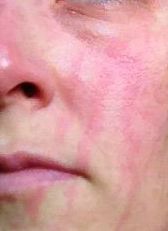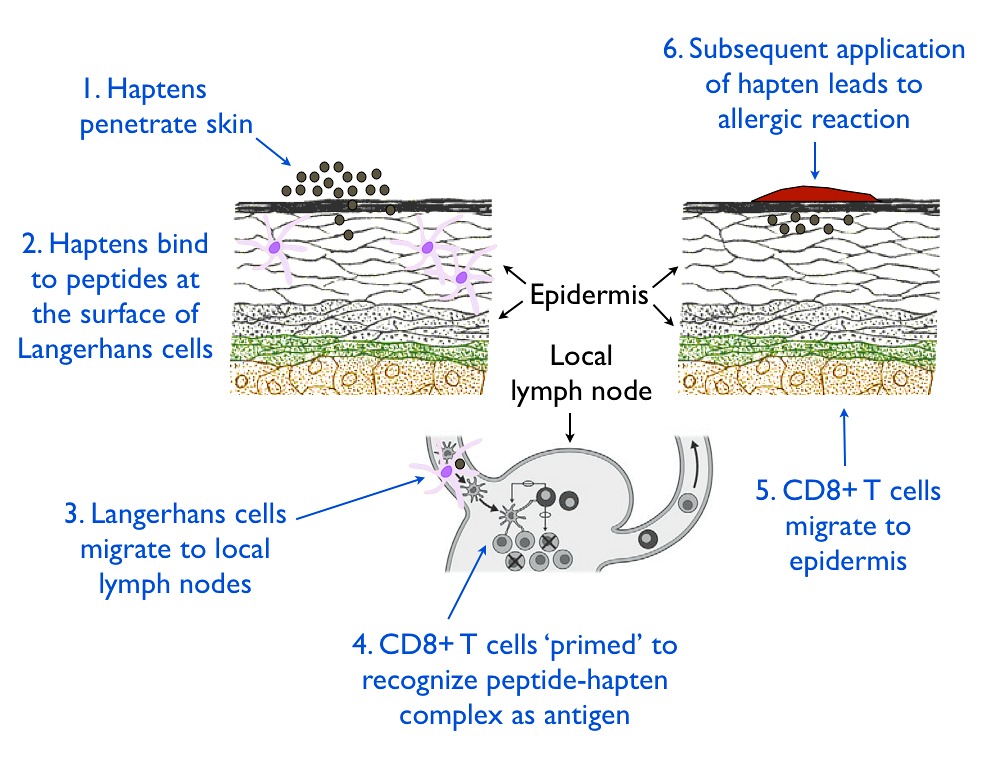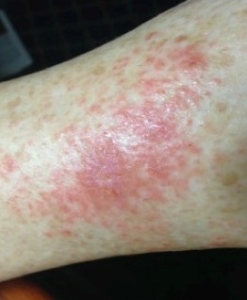Update 12/13/2017: We are very pleased to see that since the publication of our blogpost, six companies have changed their safety guidelines! Eden Botanicals now has 0.07% as the recommended dilution for Cinnamon Bark oil, and Organic Infusions, Nature’s Gift, Ananda Apothecary and Barefut. all give 0.1% as the maximum. All of these are in line with our recommendation – congratulations to those companies! See the table below for updated information.
The importance of dilution before applying essential oils topically is being increasingly recognized by both consumers and corporations, and yet “dilute before use” or similar is insufficient safety advice for some essential oils. Diluting cinnamon bark oil to 20% for example, may not protect you if it needs to be diluted to 0.1% to avoid an adverse reaction.
Full Cinnamon Survey Special Report Available for sale here.
Risk vs benefit
Adverse reactions to herbal preparations are as old as plant medicine; Dioscorides refers to several in his herbal text, written 2,000 years ago. And perhaps it makes sense that if something is a strong medicine, then it may cause problems for some people. Cinnamon bark oil is quite a potent substance, due to its high concentration – around 80% – of cinnamaldehyde. Some of the outstanding properties of cinnamaldehyde are highlighted below, along with the number of research articles (citations) found in the medical database PubMed in October 2015.
Cinnamaldehyde research on PubMed
 Topically allergenic / irritant
Topically allergenic / irritant
174 Citations
The downside.
Antibacterial
134 Citations
One of the most potent antibacterial constituents in essential oils.
Antifungal
111 Citations
A very potent antifungal too.
Anticancer
79 Citations
No human trials, but this strongly suggests a potential.
Antidiabetic
20 Citations
Promising research, some clinical.
Cinnamaldehyde has some beneficial properties, but allergies are undesirable, so the challenge is to identify a dose or dilution that is effective, and also safe for at least 99% of us. Since nothing is totally risk-free, this may require a trade-off between risk and benefit, but generally, we look to minimize risk. And let’s be clear about one thing – if we’re going to assume that the benefits of cinnamaldehyde apply to cinnamon bark oil, which is quite reasonable as it’s 80% of the oil, then we also have to assume that the adverse effects of cinnamaldehyde apply to cinnamon bark oil. If you want to rule out the research on adverse effects because the cinnamaldehyde used in the research was made in a lab, or because the tests were done on isolated cells or animals and not humans, well then that will also rule out most of the good stuff.

Adverse reaction to an extremely low dilution of
cinnamon bark and peppermint oils in a shampoo
Also, the adverse reactions being discussed here relate to the skin, and we have not explored the potential for cinnamaldehyde-rich oils to irritate mucous membrane, though there certainly is such a potential. In a review of cinnamon, cinnamon oil and constituents, Navabi et al (2015) comment: “Despite the above reported studies that promote the use of cinnamon applications in food and cosmetic products, the oral ingestion or skin application of cinnamon or its components (i.e. cinnamaldehyde, eugenol and cinnamic acid) is not always advisable and is recommended only in very small doses.”
Haptens and adverse reactions
In the aromatherapy world, the most common type of adverse reactions are skin reactions to topically applied oils. Adverse skin reactions (ASRs) are also one of the most obvious types of adverse event – when it happens you can feel it, and others can see it. ASRs are divided into four broad categories:
1. Irritation (irritant contact dermatitis)
2. Contact urticaria (immediate hypersensitivity)
3. Allergic contact dermatitis (delayed hypersensitivity)
4. Photosensitivity/phototoxicity
It has been said that it’s impossible to have an allergic reaction to essential oils, because they do not contain proteins, and only proteins can cause allergies. However, an allergen is a substance, protein or non-protein, capable of inducing allergy or specific hypersensitivity.

The process of haptenation and allergic reaction
Our immune system can’t recognize very small molecules such as those found in essential oils but, perhaps unfortunately, haptenation gets around this. The concept of a ‘hapten’ emerged from a series of articles by Landsteiner & Jacobs beginning in 1935, and is Greek for ‘to fasten’. Some essential oil constituents, such as cinnamaldehyde, can cause allergies because they are haptens. This means that they are ‘protein-reactive’; they bind with proteins in the skin. More specifically, they bind with peptides (short chains of amino acids) on the surface of Langerhans cells, and the Langerhans cells then migrate to local lymph glands, where the peptide-allergen complex is presented to T-lymphocytes. Antibodies are then created, and the next time the same hapten contacts the skin, an allergic reaction is almost inevitable.
Cinnamaldehyde is the most widely studied essential oil allergen. We know for example that it activates a signaling system in Langerhans cells, and this is what causes them to become active and migrate from the epidermis to local lymph nodes (Ouwenhand et al 2008). This migration is an essential step in the allergenic process.
Irritation reactions are quite different to allergic reactions, as they do not involve the adaptive part of the immune system. If your skin becomes inflamed after applying an essential oil, applying a vegetable oil may help to calm down any type of adverse reaction, especially an irritant one. However, if you have had an allergic reaction you cannot take away the antibodies you now have. You have acquired an allergy to an essential oil constituent, for life. Topical allergies sometimes do fade, in a similar way that you may need a boost for an immunization after 10 or 20 years because your immune system no longer produces antibodies. But usually it’s that kind of time scale – decades. And it might never fade. Better than waiting to see if your skin becomes inflamed is to prevent it from happening at all, and the best way to do this is to understand appropriate dilution.
Our cinnamon oil survey
The Tisserand Institute conducted a survey in order to find out more about ASRs to essential oils as used by aromatherapy enthusiasts, and I co-authored the subsequent Special Report with Kelly Ablard and Christine Carson. We selected cinnamon bark and cassia oils for this survey since both are high in cinnamaldehyde, and this constituent is regarded as a potential irritant and allergen by dermatologists. Since 1995, 270 of 14,007 dermatitis patients who were patch tested with a 1% concentration of cinnamaldehyde had an adverse reaction to it (See Cinnamon Survey Special Report). That’s a little under 2% of those tested, and this makes cinnamaldehyde the most high-risk essential oil constituent known from patch testing (Tisserand and Young 2014, p93).
There are accounts in the dermatology literature of adverse reactions to cinnamon bark oil applied to the skin. Repeated use of diluted cinnamon oil has caused allergic contact dermatitis (Ackermann et al 2009, Calnan 1976, Sánchez-Pérez and García-Díez 1999), and use of undiluted cinnamon oil has caused irritation (Perry et al 1990). One case was so severe that it was classed as a 2nd degree chemical burn (Sparks 1985).
Click image for 16 page survey report
In our survey, we found a very high incidence (27%) of reported adverse reactions to cinnamon bark or cassia essential oils, and we found that using undiluted essential oil on the skin did increase the risk of adverse reaction. Another risk factor, as well as dilution, is frequency – the more often you apply the same substance, the greater the risk. This combination of risk factors seemed to be borne out in the results of our survey,
Our survey did not directly address the issue of why one person can use undiluted cinnamon bark topically and not experience an adverse reaction, while another will react to a 5% dilution. However, we did find an interesting correlation. We found that people with seasonal allergies are six times more prone than average to adverse skin reactions to cinnamon bark and cassia essential oils. There may possibly be a genetic reason for this.
Our findings suggest that, for many brands, there are insufficient safety guidelines on the labels of these essential oils. Label information was not part of our survey, but we believe that advising non-specified dilution, which seems to be common, does not provide sufficient protection for consumers for these two oils. Based on our survey results, we suggest that a recommended maximum dilution of 0.1% should be adopted within the aromatherapy industry. That’s equivalent to one drop in 30-40 ml.
What cinnamon oil retailers in the USA currently recommend
For the purposes of this blog post, I looked at 30 retail suppliers of cinnamon bark oil, to see what safety advice for topical application was given online (Table 1). I found that generally there is a very high level of awareness that this essential oil presents some risk, with two out of three referring to it as a potential irritant or sensitizer. No supplier seems to suggest that dilution is not required before application to the skin. However in this list, only the first 19 (63%) either prohibit use on the skin completely, or specify a dilution. The remaining 11 suppliers (37%) recommend diluting the oil, but without stating by how much.
It’s clear from this exercise that there is an enormous range of recommended dilutions being given, including 0.07% and 20% – a difference of almost 300 times. I believe this needs to change, and I am especially concerned that the two largest retailers, Young Living and DoTerra, are among those that only suggest non-specific dilution.
Table 1: Retail suppliers of cinnamon bark oil and online safety guidelines
Table 1 includes retailers based in the USA. It may not be a complete list, but it is representative of the range of guidelines given for cinnamon bark oil. This information was obtained from online searching, and it is possible that product labels have different guidelines.
The importance of essential oil dilution
There are safety guidelines that exist in order to minimize ASRs. The International Fragrance Association (IFRA) has a voluntary code for the fragrance industry, and began issuing guidelines in the early 1970s. These are based on testing carried out by a sister organization called RIFM, which includes tests on panels of human volunteers. For example, patch testing on a panel of 25 volunteers by RIFM using cinnamaldehyde produced reactions in two of the 25 when tested at 0.5%, but 11 people when it was tested at a 2% dilution (Opdyke 1979). This is because ASRs are dilution-dependent; the greater the concentration of the substance on the skin, the greater the risk.
Safety guidelines exist to protect those who would likely have an adverse reaction, and in many cases this is a minority. Whether it’s 1%, 5% or 10% of people it’s a minority, meaning that most will not experience that particular adverse reaction. This of course does not mean that a safety guideline is wrong or can be ignored. In recent years, I have come across many reports of adverse skin reactions from aromatherapy enthusiasts applying undiluted essential oils topically. These reactions may not happen for a while – weeks or months in some cases, and maybe never – but if and when they do, they are not pleasant.
Using undiluted essential oils on your skin may be reasonable for some essential oils, for some problems, and for some people. But generally it’s not a good idea because of safety issues. Using concentrated essential oil may not even be useful, but it depends on what you are trying to achieve. Table 2 is a general guideline for essential oils, which should keep you as safe as possible while retaining therapeutic effect. There are also guidelines for high-risk essential oils such as cinnamon bark, as well as for specific age ranges, which can be found in Essential Oil Safety.
Table 2: General guideline for essential oil dilution
| End use | Dilution range |
|---|---|
| Facial cosmetics | 0.2-1.5% |
| Body massage | 1.5-3% |
| Bath & body products | 1-4% |
| Specific problems | 3-10% |
| Pain, wounds | 5-15% |
| Acne lesions, insect bites, fungal nail infections |
25-100% |
Dilution cannot be overemphasized when it comes to all essential oils, but is especially important for cinnamon bark and cassia. A little really does go a long way and if you proceed with caution, you may be able to benefit from some of the amazing properties of these oils for longer, and with no adverse reaction.
Calnan CD 1976 Cinnamon dermatitis from an ointment. Contact Dermatitis 2:167-170
Opdyke DL 1979 Monographs on fragrance raw materials. Food & Cosmetics Toxicology 17:253-258
Sparks T 1985 Cinnamon oil burn. Western Journal of Medicine 142:835
Full Cinnamon Survey Special Report Available for sale here.




Could I get some clarification here… I did not check the source info, but I’m sure that all is in order. I did see that the Young Living source (in the chart) is a secondary source and not the YL site itself. Thanks for all your research and I do use your information as a guide often in what I do. Your book on SAFETY is always on my desk! This is the quote from a rep who was asking me about the article… “I see that this article was written this month, which is great, except that they are saying that YL (in their chart) states that Cinnamon Bark needs to be diluted and then quotes our dilution information. But they link to a site that isn’t even ours and it has old information, as Cinnamon Bark is now dietary only. He has misrepresented YL a bit here in my opinion.” Thanks for your consideration
Thank you Carla. I have ordered a bottle of Young Living Cinnamon bark oil, to see what is on the label. However, this does seem to be current YL information: “3. What is a hot oil? – “Hot oils” are oils that, when applied to the skin, can cause a hot or burning sensation. YL recommends using a patch test procedure prior to first use. To perform a patch test, apply 1-2 drops of EO to a patch of skin such as the forearm. Observe that area of skin over the course of 1-2 hours for any noticeable reaction; usually reactions occur within 5-10 minutes. If you experience a hot or burning sensation or if you develop a rash, add V-6 carrier oil to the affected area as often as needed. Examples of “hot” oils include cinnamon, clove, lemongrass, peppermint, oregano, thyme, Exodus II, and Thieves.
4. What if I experience skin discomfort or irritation? – If discomfort or irritation occurs, stop using the EO, and apply V-6 or other carrier oil to the affected area. Never use water in an attempt to flush the oil off the skin, as this may increase discomfort. If a rash occurs this may be a sign of detoxification; drink adequate water to encourage the release and removal of body toxins.” https://www.youngliving.com/en_US/discover/essential-oil-safety This patch test procedure, if used with undiluted Cinnamon bark oil, would be highly unsafe, and as I explain in the blog post above, applying vegetable oil once you have had an allergic reaction is not going to take away your allergy. And, a rash following essential oil application is never a sign of detoxification https://tisserandinstitute.org/essential-oils-and-the-detox-theory/ this is total myth, and drinking water will do absolutely nothing to alleviate an allergic reaction. Finally, Cinnamon bark oil is defined by YL as a “hot oil”, which is defined as one that can cause a hot or burning sensation. However, an allergic reaction is very much more than a hot or burning sensation https://en.wikipedia.org/wiki/Allergic_contact_dermatitis. I see nothing anywhere that tells me Young Living is advising consumers not to apply Cinnamon bark essential oil to the skin. If this is in fact what the company is now saying, please provide a source link.
Hello Mr.Tisserand,
Thank you for posting all of this research. I am interested in your research and allergic reactions from essential oils. I’ve used essential oils for years, mostly topical and in the air, occasionally internally. Recently I had a food sensitivity blood test done and found that I showed high sensitivity to 4 different items, which to my surprise, where plants that I typically used topically as essential oil applications. They were: ginger, orange, lemon, and grapefruit. I had been applying a combination of diluted ginger and orange on my wrists almost every day to ward of nausea and I take a few drops of lemon oil on occasion in my water. I’m trying to understand the connection between these items now showing up as sensitivities in a blood test. Thank you for any insight, knowledge, or research you can provide. Kindly, Leigh
Hello Leigh you don’t say what kind of test this was for food sensitivity. But anyway, if your skin is not becoming inflamed from the application of these oils, then there’s not reason to not use them topically. Whole plants contain many more constituents than are found in the equivalent essential oils. Whether you should stop using those foods is for you to decide along with your practitioner.
Interesting, but not surprising results, Robert. Cinnamon is one that is commonly reported as causing a reaction when applied topically. Your survey confirms my findings that those with a compromised immune system (allergies, autoimmune disorder, chronic skin conditions) are far more likely to experience reactions and should dilute more heavily.
Thank you so much for all this incredible information. I would, however, like to point out that cinnamon bark is not recommended for external use in the first place but rather it should be used, when used, internally. It is a bit of a poor example to support the new campaign to always dilute essential oils because there are many other essential oils when used for some acute conditions that are actually quite beneficial when used undiluted. Research is so amazing with the insights in can provide as are adverse reactions to essential oils that should not be put on the skin in the first place, but ultimately my final decision on how best to apply a given essential oil comes from actually working with the essential oils and observing which ones can go directly on the skin, under what or for what conditions, and for what individual. To say ‘never use an essential oil undiluted’ is simply not a valid statement, at least in my humble and much experienced observations of utilizing essential oils. – Al always, Warm regards, Jade
Thank you for your comment Jade. You don’t give a source for “cinnamon bark is not recommended for external use”, though in the retail environment, only 3 out of 30 companies listed above advise not using the oil topically, and our survey found that consumers do use the oil in this way, sometimes undiluted. I stand by the conclusions of our Special Report, which highlights that adverse reactions from topical use can happen, and that there are existing safety guidelines (whether you look at IFRA, The Good Scents Company or Essential Oil Safety) and also labeling guidelines which seem to be ignored by some businesses that sell essential oils. I am not aware that I said “never use an essential oil undiluted” I did say “I have come across many reports of adverse skin reactions from aromatherapy enthusiasts applying undiluted essential oils topically.”